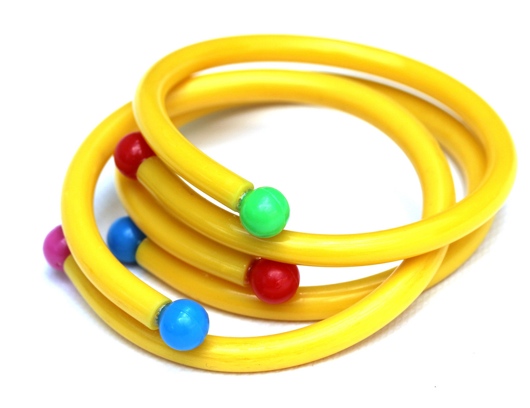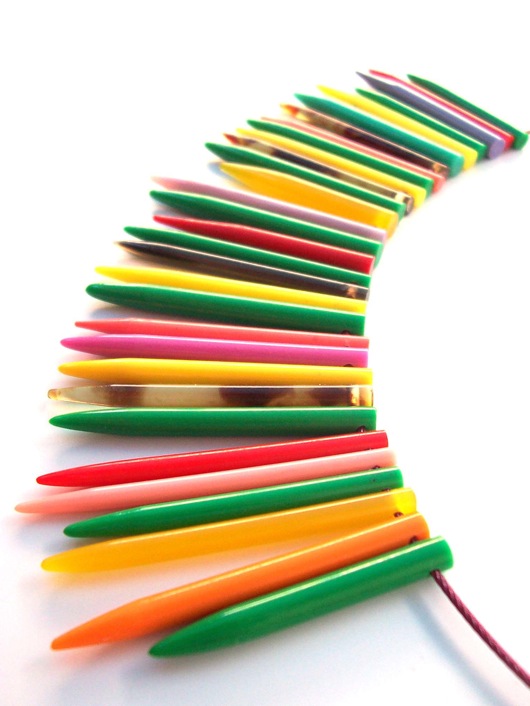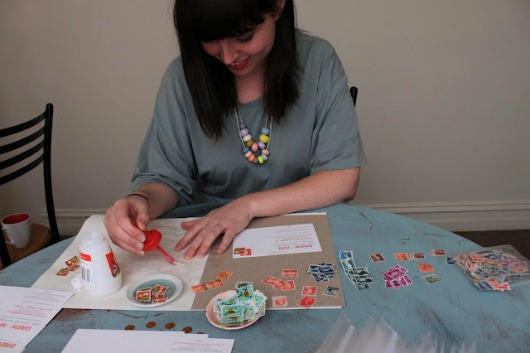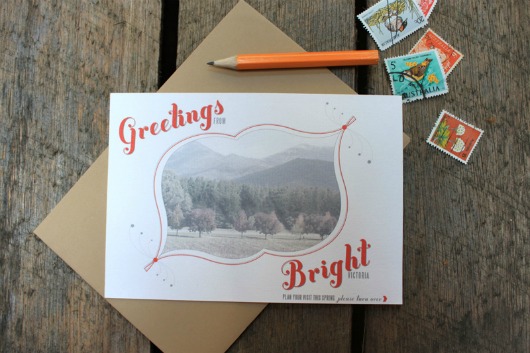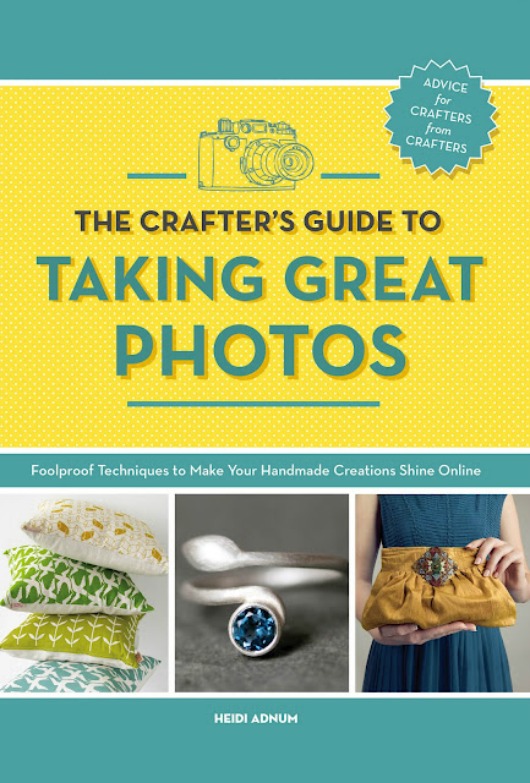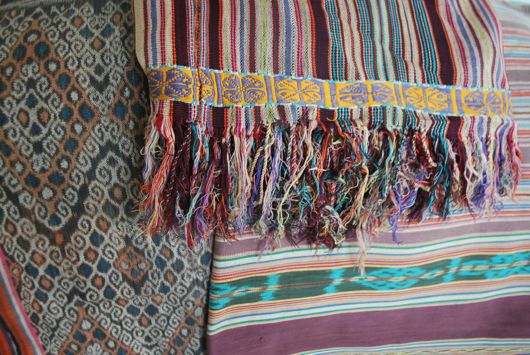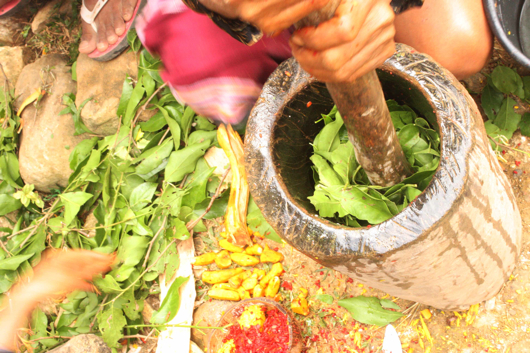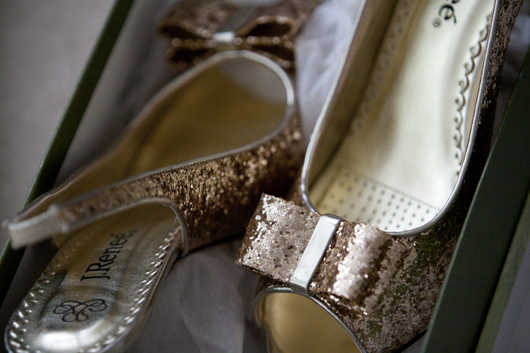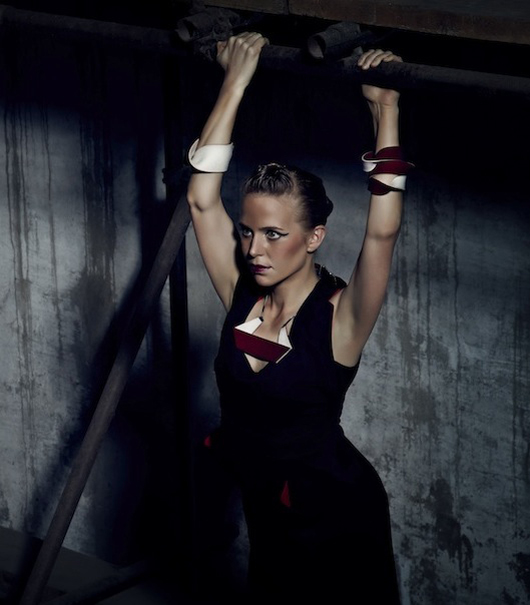Eco-friendly Practice: Liana Kabel
By Phoebe Miller In my opinion, this month's eco-friendly creative lady featuree embodies a lot of what the CWC is all about. Liana Kabel juggles motherhood with running her own creative practice and working with other women to help turn their dreams and ideas into business success. From my observation, she does it all with a smile and the attitude that while it might be a challenge, it's also rewarding and incredibly worthwhile.
Liana Kabel Push Pin Bangles - knitting needles, push pins
Originally from Sydney, but now residing in Brisbane, Liana has a diverse, broad ranging creative background, with experience in ceramics, photography, painting, fibre arts, costume design and the performing arts. These days her artistic practice focuses on the design and handcrafted production of contemporary jewellery, predominantly using recycled plastics. With a Tupperware Lady mother and jeweller father, she says it's hardly surprising where she's ended up!
Knitwit Necklace by Liana Kabel - vintage knitting needles, stainless steel, button
What do you do/ design/ make? I’m a jewellery designer with a focus on using recycled plastics. I’m really interested in going beyond the jewellery in the future to include more sculptural work and wall pieces.
I am also the manager of the Brisbane programs for Bizness Babes, a not for profit organisation with a range of business training programs for women who want to turn their idea into a business.
What are the key elements in your sustainable or eco-friendly approach? Most of my materials are recycled, found, vintage plastics and metals, sourced locally.
I’m keen to create as little waste from any project as possible, but when I do, I try to use the waste in other projects. For example, my love knot rings and knot brooches are made from the middle sections of the knitting needles, once I’d used the tips and tops for necklaces and earrings.
Liana Kabel studio detail
Where do you source your materials? I’m always on the lookout! Markets and op shops are a great source, however lots of my materials are donated. Customers, friends and relatives will often send me parcels of odd knitting needles, buttons, plastics lids etc. Reverse Garbage is a great source whenever I need something like acrylic or rubber.
Many of the materials I’m using this year are from my relatives. My Uncle had a jewellery factory in Sydney and so did my Great Uncle. My Father and another Uncle also had a jewellery retail and wholesale business. I’ve inherited some of the materials that span over 60 years of their various businesses.
Liana Kabel earrings materials
Is there anything you’d like to do or learn to make your work even more eco-friendly or sustainable? I’d really like to learn more about bio resins/eco-friendly plastics and how to work with them. I’m also interested in collaborations with other designers/artists across different fields who share a similar focus. I am also going to work more on make more small changes such as packaging, printing etc. They all can add up to much.
Tupperware Dress by Liana Kabel - recycled Tupperware, steel jump-rings
Are there any other designers or businesses doing new or interesting things with an environmentally aware focus that you admire or are inspired by? I love amazing design done well with as little environmental impact as possible. I think it’s great when the first thing you notice is great design. Melissa shoes are a great example. Melissa has been quietly leading an ecological fashion revolution for nearly thirty years. Melissa shoes are made from eco friendly mono materials that can easily be disassembled and recycled. 100% of materials are used in production. No waste. No dumping excess into landfill.
I am always inspired by businesses that are as much about people as the environment - when the social and environmental impact is considered equally. When those can go hand-in-hand I think the impact and long term benefits are the greatest.
Where can we view and/or buy your work? Stockists and my online shop can be accessed via my website.
Liana Kabel Pied Piper Necklace - vintage games counters, recycled acrylic, coat hangers and sterling silver
Phoebe Miller is a Brisbane-bred, Sydney-fled, Melbourne-embedded gal who enjoys making, spruiking, collecting, exploring, telling her friends where to eat and posting photos of doors on instagram. After several years working in corporate marketing and communications, Phoebe followed the urge to explore her creative side. These days she divides her time between her sustainable fashion accessories label, Simply Phoebe, and freelance PR consulting.
Featured Member Interview: Jessica Hyde
By Roslyn Russell Are you looking for those perfect wedding invitations, a print to brighten up your space, or a custom illustration for your event or business? Look no further and please welcome Jessica Hyde from truth.be.told as today's featured member on the CWC blog.
What do you create?
I create a range of stationery products based on my illustrations for my little label truth.be.told. I also do some freelance illustration and design work including designing custom wedding and event invitations for a bunch of sweet couples. In my spare time I write about my work and all manner of other things over on my blog truthbetold.
Have you done training in your creative field or has it come about informally? It has all come about sort of organically. I didn’t train as a graphic designer or illustrator, at university I studied Architecture, which gave me a great appreciation of design and the context we create in. While studying I was really fortunate to have a lecturer who really encouraged us to explore presentation styles and create by hand. Over time I realised that I loved this presentation side of things more than anything that would be a part of the reality of being an architect. When I finished my degree I knew that I didn’t want to be an architect, but I also knew that I loved drawing and designing. So in my spare time I started illustrating and making pieces for my friends which over time developed into starting truthbetold, designing my own stationery range and designing for others.
What are your main creative inspirations? For me it is more a case of what am I not inspired by, I think it stems from my short attention span! I collect a lot of old books - atlases, pattern books, fashion, advertising, architecture, photography - that I constantly flick through for inspiration. I also love old movies and movie posters from the 40‘s and 50‘s. I really love reading about what other people are doing and their practices, I find it really drives me to keep going when I am not feeling motivated.
How do you balance your creative projects with the administration aspect of creative work? I definitely struggle to balance the business and creative sides, I would much rather be designing than writing invoices. I also work full time in architecture so everything for truthbetold has to fit in around those hours which is an extra challenge. I write a lot of lists and have found writing a weekly, monthly and quarterly plan helps me keep up to date with the administration and stops me from over committing myself.
I am also an early riser so I’ve found spending an hour before work dealing with any administration means I am more productive and focused when I come home from my day job and start my own work. I guess I don’t sleep a lot, but I wouldn’t have it any other way.
What do you do when you experience a creative block? My creative blocks are almost always a result of being overwhelmed by ideas or having too many things on my plate. I will usually take a break and spend an hour on a different project or just spend some time drawing something unrelated. I also find that just taking a break and doing something unrelated helps me unconsciously slow down my thoughts and focus. I can’t tell you how many times I have solved a design problem while watching a movie!

What future goals do you have for your creative pursuits?
Ideally I would love to be doing this full time one day but that is a long term goal. Shorter term, I am hoping to create more opportunities to design for events such as weddings. I am currently developing a new range of products for events, as well as new designs for the stationery ranges.
I also want to continue the custom design and illustration side of the business. I would also love to extend this into event styling or visual merchandising possibly.
My main goal is just to keep working with great people on interesting projects because I really love designing something special for them, nothing makes me happier.
Thanks for sharing your creativity here today Jess! You can find out more about Jess and truth.be.told via the links below.
Roslyn Russell is a sewist, blogger and teacher. Her blog, Sew Delicious, is where she showcases her latest projects, designs and sewing tutorials. Roslyn also enjoys cake baking and decorating, exploring Melbourne cafes and restaurants, and hunting through op-shops for vintage sewing and kitchen treasures.
Book Review: The Crafter's Guide to Taking Great Photos by Heidi Adnum
By Jodi Wiley My photography skills are pretty basic and I'm still using my advanced compact on 'auto' - not that there's anything wrong with that - but I figured it was about time me and those fancy settings got better acquainted.
The Crafter's Guide to Taking Great Photos by photographer and crafter, Heidi Adnum, is full of useful information for the amateur picture taker. I use a lot of trial and error to take my own blog photos. A little less 'error' would be great though, which is where this book comes in. If you photograph your own products for your blog, website or online shop then this book is aimed squarely at you. But it's also great for people who keep a blog and just want to take lovely photos of 'things'.
But this book isn't just about getting to know your camera settings, although it definitely covers that in detail (the first chapter is 'Camera Basics' - light, aperture, shutter, exposure - the usual suspects) but it's a whole lot more than that. There's information on 'how to tell your story' which gets you thinking about how you want your products to be perceived. It shows how you can alter the 'feel' of your items using techniques such as composition, backgrounds, props and styling. There are also handy DIY tutorials on making camera accessories like a light box, flash diffuser and seamless background.
The main body of the book covers how to photograph just about every form of craft you can think of: Fashion and Fabrics, Jewellery, Art, Home Accessories and more. Each section also includes an FAQ with questions such as: 'My home accessories would look great featured in a beautiful home. Problem is, though, I live in a tiny less-than-photogenic apartment. Help!' Can anyone else identify? Each section also ends with a spotlight on a particular crafter. It's great to hear how actual people have solved their photography problems and improved over time. Really useful stuff.
The final third of the book goes through photo editing tutorials, image handling (protecting copyright, saving and storing, troubleshooting) and business advice.
This book is touted as containing 'foolproof' techniques for creating great product photos and it's certainly easy to understand. It's light on jargon and very readable. It's also jam-packed with lush photos of gorgeous products so it's easy on the eye too.
I'm loving this book right now. Combined with the tripod I just got for my birthday I should be taking top photos in no time! Now if only I can figure out those settings...
The Crafter's Guide to Taking Great Photos is published by Murdoch Books.
Jodi Wiley is an artist, writer, teacher and blogger. She has written freelance articles and book reviews for magazines and newspapers, as well as education curriculum. She has has won awards for her artwork and been a finalist for several art and illustration prizes. Jodi is currently on maternity leave from high school teaching and is on a (quite frankly deranged) quest to update her blog daily: artbywiley.com
Women in the World: East Timor
I’ve been recently pondering on the role that creativity plays in a country’s cultural identity. Think of the countries you’ve traveled to… Many of them I’m sure, can be associated with a particular type of artistry or craft. Just think of Turkey and their kilims, Japan and woodblock printing, South American ikat weaving…
In many of these examples, these handcrafts are not just an outlet for creative expression (although that is true and important), but are also a way of holding and sharing stories and history. Many countries have little in the way of recorded written history, but have a rich culture of oral histories. And handcrafts and art play a vital role in recording these and allowing them to be shared and passed from one generation to the next.
Take East Timor (Timor-Leste as it is now known and referred to there), one of Australia’s closest neighbours and incongruously, the poorest nation in Asia and the Pacific. Timor Leste is a tiny country with a population of just over 1 million people. It faced oppressive rule until recently, and now is struggling to pull its people out of poverty.
Despite its tiny size, Timor Leste has over 35 languages spoken and fairly rough terrain, making it difficult to have a united recorded history, and making the use of traditional crafts all the more important. One of the most prevalent and important is the weaving of beautiful fabrics called ‘tais’ (pronounced ‘tie-iss’).
Between 2005 and 2007 I lived and worked in its capital Dili, and not surprisingly, I spent many an hour wandering through the markets which sold these beautiful fabrics. I also spent time with women in remote villages who were weaving them and witnessed the important role the weaving played in village life, and how the knowledge contained in its practice was being passed down from the grandmothers to the grandchildren.
I recently asked some questions to Taryn Lane, an Australian woman living in the Southern tip of East Timor and working with the Cooperative for Tais Culture and Sustainable Development (CTKDS).
Taryn writes (after several days of no electricity thanks to major storms!), “Tais weaving is the material expression of a rich living intangible cultural heritage of Timor Leste. Tais is the socio-cultural fabric of life that keeps women connected to their history, stories and ways of being”.
“Many women see weaving as a process of wellbeing and healing after many years of occupation. It is an unbroken thread over eras of rapid change and development. Creativity releases the burden of daily work for the women and connects them to a living heritage of cultural expression”.
“Many Timorese women will learn how to weave from an early age and are immersed in it as it relates to ritual and the cycles of nature. The harvesting of the cotton, the spinning, dyeing and weaving all follow the seasonal patterns of their local area. Each area has its own recipes and processes for the colouring of the cotton and there is a rich intact cultural heritage within East Timor around this".
"Tais are usually necessary for wedding dowries alongside buffalo and to become a weaver is often a rite of passage for many women prior to marriage. Each language group holds their own motifs and stories around the textiles and are a unique expression of who they are”.
The challenge now, for many countries including Timor Leste, is to ensure that these traditions are not lost and that the knowledge and skills are passed on to younger generations. Organisations such as CTKDS are assisting to do this by supporting young women as the next generation of leaders and using community co-operative enterprise models for income generation.
If you are in Australia, you can find out more through ETWA (East Timor Women Australia) and buy or sell the beautiful products that Timorese women make. You can also volunteer, assist in fundraising, take a tour to Timor and if you are really interested, apply for a long term position in Timor Leste!
Further information can be found at www.ctkds.tumblr.com or www.etwa.org.au, or email ctkds.losplaos@gmail.com.au
Joanna Francis spends most of her time hanging out with her one year old son. But she also works for a children’s foundation and has recently started her own little business making baby quilts. Her house is a mess. In the past, Joanna has worked as an aid worker in several developing countries, and is passionate about the rights of women and children. You can visit her and her blog at www.miettehandmade.com
Scenes From Sydney: Embracing Change
By Jaclyn Carlson The changing of the seasons, the slow and often sullen shift from summer to autumn has caused me to explore and embrace the idea of change and transformation in our lives. As women, very few of us get to change our careers, shift directions and follow new paths. For many it’s the responsibility of family, for others the burden of finance but often it’s fear that holds us back and allows self doubt to creep in and spread like wildfire until our desire for change and dreams of a new path become just that…an old and distant, dream.
Without wanting this post to sound like something out of Sylvia Plath novel, my purpose for embracing change this month was to highlight a few bold women who have made mid-career and/or life changes and haven’t looked back since. They've embraced the fear, chased down impossible obstacles and have carved out new careers and hobbies one step at a time. Hearing their stories is not only a source of admiration but inspiration and something we could all learn from. Whether it be big or small, life changing or not, we all need a bit of change to push us forward…
Emma Scamell , Emma Scamell Photography Sydney-sider, Emma Scamell has turned a love for photography into a blossoming Sydney-based business. Drawing on her skills as a marketer and using a business savvy approach, she is the perfect example of what happens when you allow yourself to follow your heart. Below she shares with the CWC what change means to her and the moment she decided to move on a new path…
When did the idea of change first become clear to you? A few years ago, I read a quote in an article by Ralph Simon which really resonated and stuck with me. "Work hard and be nice to people. Do what you love, then it’s not work”. The work hard and being nice is essentially my ethos, but I made me think, is it actually possible to turn what you love into a career?
When did you decide to take the leap of faith and follow your dream? I’ve been working in marketing for around 8 years and had been wondering if the dream of working for yourself could actually become a reality. I have always loved taking photos and began expressing that dream to others. As soon as I started verbalising it, things started happening completely organically. I started getting asked to do shoots through friends, and then friends of friends, and I started to take the concept of going full time more seriously. After a long lunch with a friend who has just launched their own business, I realised that it could be more than a pipe dream and there was no reason why I couldn't do the same. From that lunchtime onwards, I’ve made sure that every day, I have done something to take myself closer to my goal – be it shooting, studying, reading, researching or connecting with people.
What’s next? I've just taken some determined steps towards my goal by becoming a member of the AIPP and working on some meaty client projects in my free time. I'm also taking a strategic approach to the business with a brand and marketing plan. Yes, I absolutely have the fear of "what if no-one likes my work?", but I also know that the same fear drives me to continually improve. Above all, I know that if I didn't at least try to make this happen, I would always wonder 'what if'...
Leanne Ambrogio, Sweet Style Blogging for Leanne Ambrogio began in April 2009 as a way to document the building of her house with the creation of Mrs A In The Cove. What began as a whim, suddenly began to change direction in 2010 when she discovered the world of dessert tables and styling - something she had always been passionate about – thus began a brand new path never before imagined. Since creating her first dessert table for her daughters fourth birthday in 2010 things have not stopped. In June 2011 her new styling business took another turn when she again changed her career path to launch an online store stocking all the beautiful items that are required for creating a stylish party. The store, Sweet Style, has gone from strength to strength and the product range keeps growing. The styling side of her business also continues to grow as well with a number of requests for contributions to some lovely online magazines. Leanne is an inspiration to me personally as she continually strives to taken on new challenges and pave out her own path. She leads a busy life with family as her main priority but is one of the best examples I’ve come across of taking what starts as a small hobby and turning it into a passionate, life changing career path.
For the rest of us still dreaming of or looking for change, Megan Morton might just have the answer. She has recently launched, The School, a Sydney-based hub for discovering new talents, and unearthing hidden charms. As Megan herself sums up, “ we want to hold a candle to everyone's inner creative and tap into the magic that happens when you work with both your hands and your heart.”
Originally from Boston, Massachusetts, Jaclyn Carlson is the author behind the Sydney-based blog, Little Paper Trees. When not documenting her expat adventures, she can be found working for one of Australia’s top design & homewares trade shows. Passionate and prone to wasting hours on Pinterest, she has years of experience in marketing, advertising and PR and aims to put Sydney’s creative women in the spotlight with her monthly column
Tools of the Trade : Taë Schmeisser
By Brianna Read In this second instalment of Tools I have the great pleasure to introduce you to the inimitable Taë Schmeisser. A Melbourne based designer and jeweller, Taë’s creative background is as diverse as her jewellery collections – Taë has studied glass and ceramics and more recently engineering technology (jewellery) – her design collections utilise materials from glass through to felt. Diverse though her materials and methods of construction may be, a consistent thread throughout each range of designs is that of the body and more specifically objects to be worn on the body.
So you can understand why I chose to interview Taë about the tools of her trade – which tool could a designer like this not live without? The answer: a sketchbook and pencil. Of course! Taë also mentioned that she would be rather lost without her flexi drive drill but continued on to explain that the sketchbook is the constant player in her tool kit, she says “It’s not particularly ordered and there is a whole lot of chicken scrawl, torn out pages of magazines, photos, embarrassing and impractical ideas but it’s where it all starts.”
As a designer ever ready to embrace a new material, Taë mentions the importance of the material informing the tools. She says that with the development process of every collection the ideas have to work their way around the materials chosen. For her most recent collection, titled Architexture (launched this month under the label Bëuy), a range of wearable works of art have been created using German wool felt and metal. The results are quite simply striking.
With a genuine love of exploring new territory this is reflected in her choice of favoured tool – it is the point where the working through of an idea begins. The sketchbook is the ‘this is where I want to go’ part of the design process. Taë calls it ‘tumbleweeding’, in reference to the action of an idea rolling around in the head of the designer.
On the horizon she is looking toward a collection which returns to one of her early loves – glass; but she is certainly not traversing old ground. Always up for a design challenge, her designs are incorporating elastic, glass and metal. I for one cannot wait to see the fruits of that adventure…
Architexture by is available online at www.beuy.com.au and in store at The Queensland Art Gallery of Modern Art Shop.
Brianna Read is a designer-maker based in Melbourne. Her knitwear label Jack of Diamonds Knits employs traditional hand-made techniques in combination with machine knit technologies. Brianna’s multi-faceted creative practice encompasses design, production, works for exhibition and machine knitting workshops.
Eco-friendly Practice: Studio Common Ground
By Phoebe Miller In my own experience working in marketing and communications and creating marketing materials for my creative work, I know it can be difficult and confusing to navigate some of the options, complexities and costs involved in minimising the impact of your output on the environment. Thankfully, it is becoming easier, due to increasing in awareness and education and a growing demand for eco-friendly production.
This month we're turning our (energy efficient) spotlight onto an small design collective called Studio Common Ground, who aim to work with people who have like-minded ethical and sustainable business objectives to develop simple, meaningful and effective design. Working across a variety of projects and media, they look at sustainable outcomes for both the client and our environment with every project.
Intrigued, I spoke to Jessie Brooks-Dowsett from Studio Common Ground to find out more.
 Studio Common Ground business cards, made using unwanted paper samples.
Studio Common Ground business cards, made using unwanted paper samples.
Can you tell me about the key elements behind the eco-friendly side of your work? Sustainability, in our opinion, is about awareness and education. So with every new project we're approached to be involved in, we try and work closely with our clients to gain insight into their business objectives and then translate them into a meaningful communication design piece that is environmentally mindful. Whether that means we develop a paperless outcome, use recycled materials or create an aesthetic that relies on using techniques like die-cutting or embossing to replace ink colours. We also make sure we confer with our printers in the early stages of of the design process to understand their press sheet sizes and find the most efficient way to set up the job, maximising the amount of pieces we can fit on the press sheet and minimising the paper waste. At Common Ground we believe that these small measures will make a big difference in the long run.
We've had the opportunity to work with a lot of clients who have been environmentally mindful; printing on sustainable products and using non toxic inks or waterless printing techniques. But, I think our own branding is the best example of using materials creatively to produce a more eco-friendly result. As designers, we are sent A LOT of paper samples, stock options and paper promotions from various paper reps and whilst we could recycle most of these products, Common Ground thought we'd put an extra loop in their life cycle! We had some rubber stamps made up of our logo and now we trim up all the un-used paper stocks and samples and stamp them to make our business cards.
 Work in progress: putting good use to packaging
Work in progress: putting good use to packaging
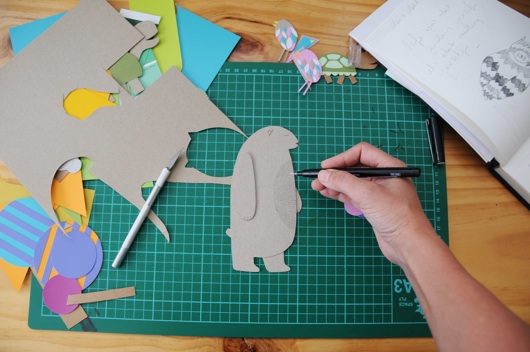 Work in progress: a bear gets some hair
Work in progress: a bear gets some hair
Can you tell us about a recent project you are particularly proud of? Common Ground was approached by Paul Ducco from All Things Considered to develop a poser for the Languages Other Than English (LOTE) student film festival. The posters were to be hung up around schools and given to all the participants, school aged children (12-18yrs old), so the artwork had to be fun, without being too childish and relate to theme the UN's theme of 2011 'Forests for Everyone'.
We sat down and did some brainstorming and kept returning to the idea that forests evoke a sense of fantasy and whimsy, of secret worlds and hidden characters. We decided to develop a set of anthropomorphicanimals and felt that in support of the forest theme we wanted to create this project without using any new materials. We collected cereal boxes, drink packaging, old paint swatches and got to work! We sketched up the characters and then set about manually cutting and pasting all of the characters together before scanning them all and digitising the final product.
 Work in progress: LOTE poster taking shape
Work in progress: LOTE poster taking shape
 Work in progress: creating a whimsy world with unexpected materials
Work in progress: creating a whimsy world with unexpected materials
 The finished product: LOTE film festival poster
The finished product: LOTE film festival poster
What challenges have you come up against in trying to make your practise sustainable and how did you overcome them? The biggest challenge I have is tracking down sustainable resources, trying to gain certification on fair trade or organic materials or track down local/community based suppliers. I wouldn't say I've overcome this yet but websites like Oh My Green, The Green Directory and Eco Directory sure do help!
Is there anything you’d like to do or learn to make your work even more sustainable? I spent the weekend at the Sustainable Living Festival (in Melbourne) and have become fascinated with permaculture, so I'd love to learn more about that, but I'm not sure that will make my work even more sustainable! I think a large part of being sustainable comes down to your community focus. If you can easily trace the source of your materials and produce your work locally there's a good chance you're on the right track. So I'd love to learn more about my community, engage closely with what other people are doing around me and hopefully create some more opportunities for fantastic collaborations!
Are there any other designers or makers with an environmentally-aware focus that you are inspired by? A lot of people are becoming more aware of our environmental and social impact, which is something I respect and admire. People are making small changes to they way they look at and approach their work, it's this level of consciousness which will make a big difference in the long run, from the kids over at Cassette who've become Carbon Neutral to the beautiful people over at See Saw who produced the most stunning and sustainable piece of work in their Finsbury Sustainability Report (2010).
But if I'm talking about the people whom I admire the most and am inspired by it would have to be the bunch over at Small Giants. They look at the big picture stuff. To quote straight from their website. "Small Giants was founded in 2007 to create, support, nurture and empower businesses that are shifting us to a more socially equitable and environmentally sustainable world. Some people call this type of business social enterprise. We just think it makes sense." I couldn't have said it better myself!
Phoebe Miller is a Brisbane-bred, Sydney-fled, Melbourne-embedded gal who enjoys making, spruiking, collecting, exploring, telling her friends where to eat and posting photos of doors on instagram. After several years working in corporate marketing and communications, Phoebe followed the urge to explore her creative side. These days she divides her time between her sustainable fashion accessories label, Simply Phoebe, and freelance PR consulting.

